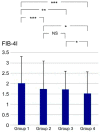Investigating the Association between Coronary Artery Disease and the Liver Fibrosis-4 Index in Patients Who Underwent Coronary Computed Tomography Angiography: A Cross-Sectional Study
- PMID: 37504557
- PMCID: PMC10380255
- DOI: 10.3390/jcdd10070301
Investigating the Association between Coronary Artery Disease and the Liver Fibrosis-4 Index in Patients Who Underwent Coronary Computed Tomography Angiography: A Cross-Sectional Study
Abstract
Liver fibrosis scores, indicative of hepatic scarring, have recently been linked to coronary artery disease (CAD). We investigated the association between CAD and the fibrosis-4 index (FIB-4I) in patients who underwent coronary computed tomography angiography (CCTA). This study included 1244 patients who were clinically suspected of having CAD. The presence or absence of CAD was the primary endpoint. FIB-4I was higher in the CAD group than in the non-CAD group (1.95 ± 1.21 versus [vs.] 1.65 ± 1.22, p < 0.001). FIB-4I was also higher in the hypertension (HTN) group than in the non-HTN group (1.90 ± 1.32 vs. 1.60 ± 0.98, p < 0.001). In all patients, high FIB-4I (≥2.67) was a predictor of presence of CAD (odds ratio [OR]: 1.92, 95% confidence interval [CI]: 1.30-2.83, p = 0.001), and low FIB-4I (≤1.29) was proven to be a predictor of absence of CAD (OR: 0.65, 95% CI: 0.48-0.88, p = 0.006). In the HTN group, high and low FIB-4I levels, were found to be predictors for CAD (OR: 2.01, 95% CI: 1.26-3.21, p < 0.001 and OR: 0.65, 95% CI: 0.45-0.94, p < 0.022, respectively), in particular. FIB-4I may serve as a diagnostic indicator of the presence or absence of CAD in hypertensive patients undergoing CCTA.
Keywords: coronary artery disease; coronary computed tomography angiography; fibrosis-4 index; hypertension.
Conflict of interest statement
The authors declare no conflict of interest.
Figures




References
-
- Jansen S.A., Huiskens B., Trompet S., Jukema J., Mooijaart S.P., Willems van Dijk K., van Heemst D., Noordam R. Classical risk factors for primary coronary artery disease from an aging perspective through Mendelian Randomization. Geroscience. 2022;44:1703–1713. doi: 10.1007/s11357-021-00498-9. - DOI - PMC - PubMed
-
- Khandia R., Puranik N., Lodhi N., Gautam B., Alqahtani T., Alqahtani A.M., Alamri A.H., Chidambaram K. Comparing heart risk scores to identify the most important risk factors for cardiovascular diseases. Eur. Rev. Med. Pharmacol. Sci. 2021;25:7947–7963. doi: 10.26355/eurrev_202112_27645. - DOI - PubMed
LinkOut - more resources
Full Text Sources
Miscellaneous

